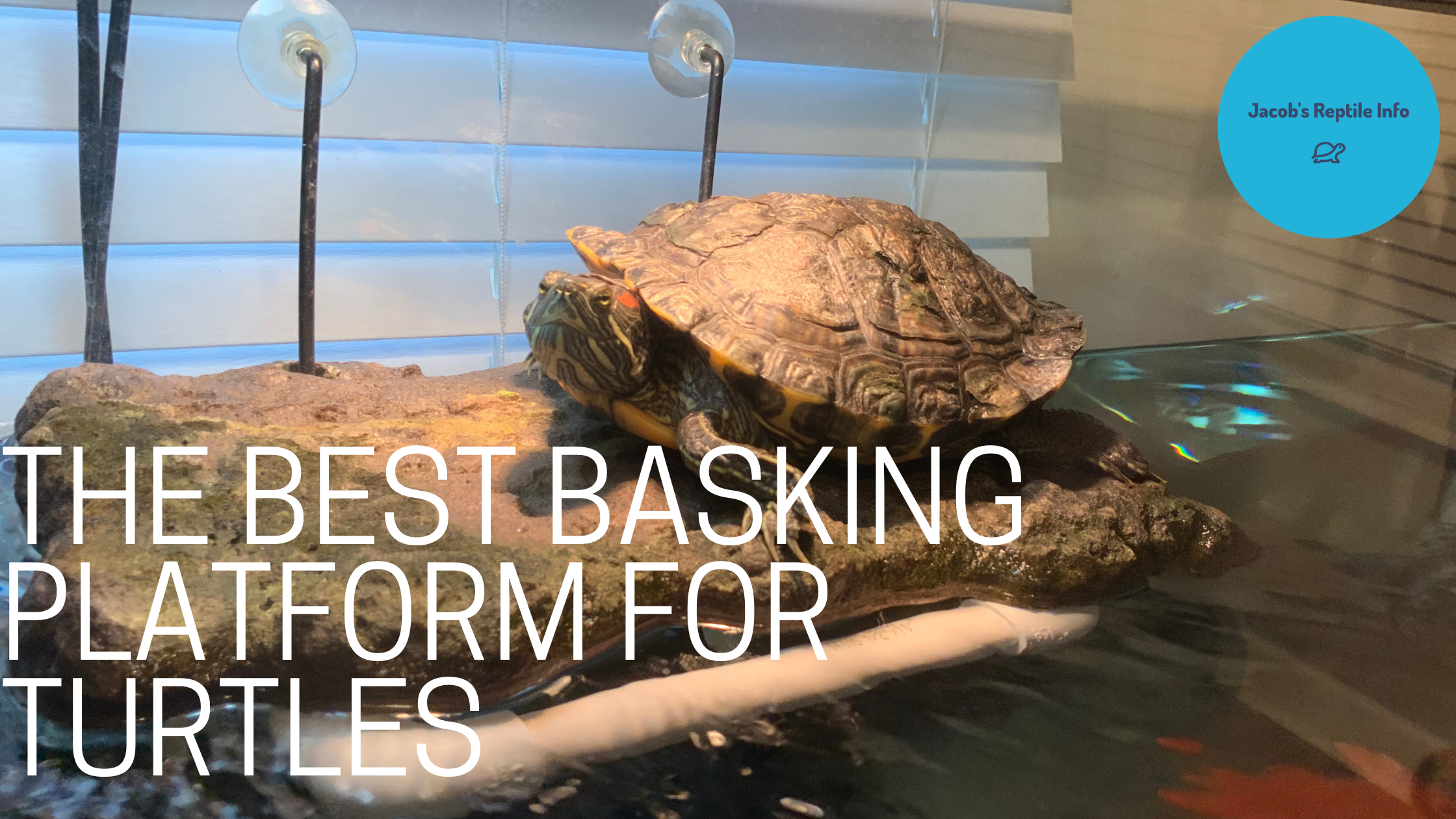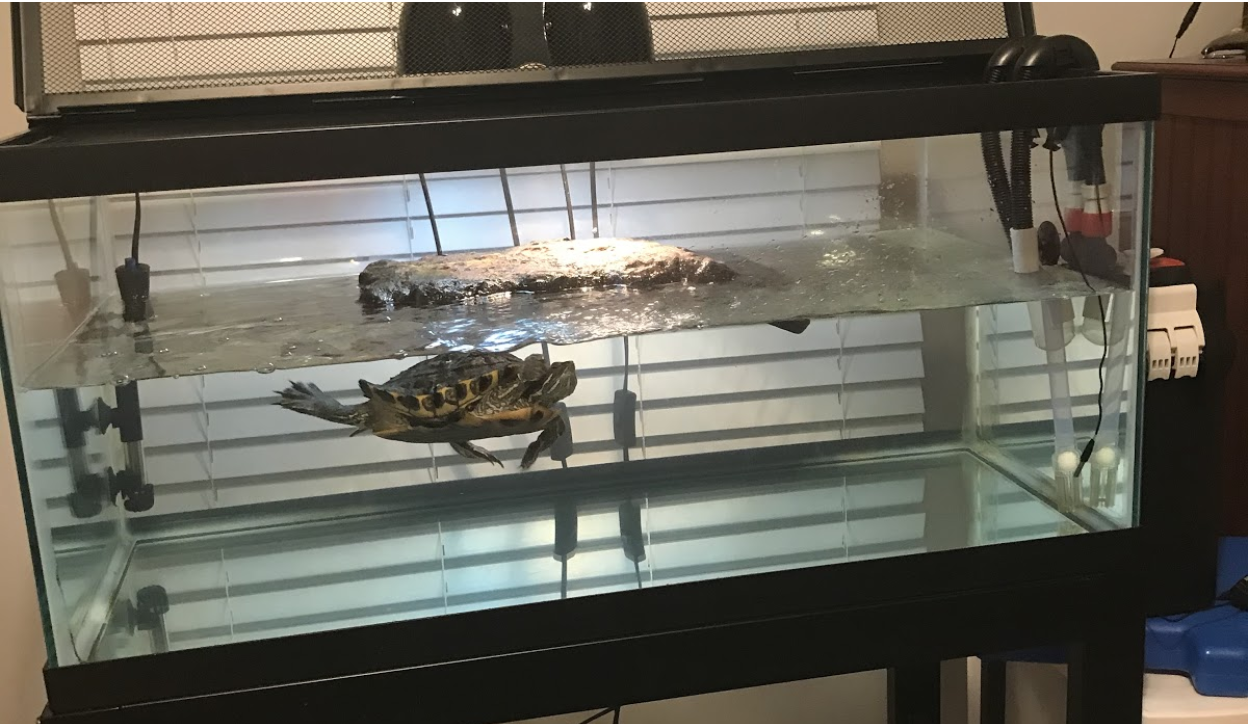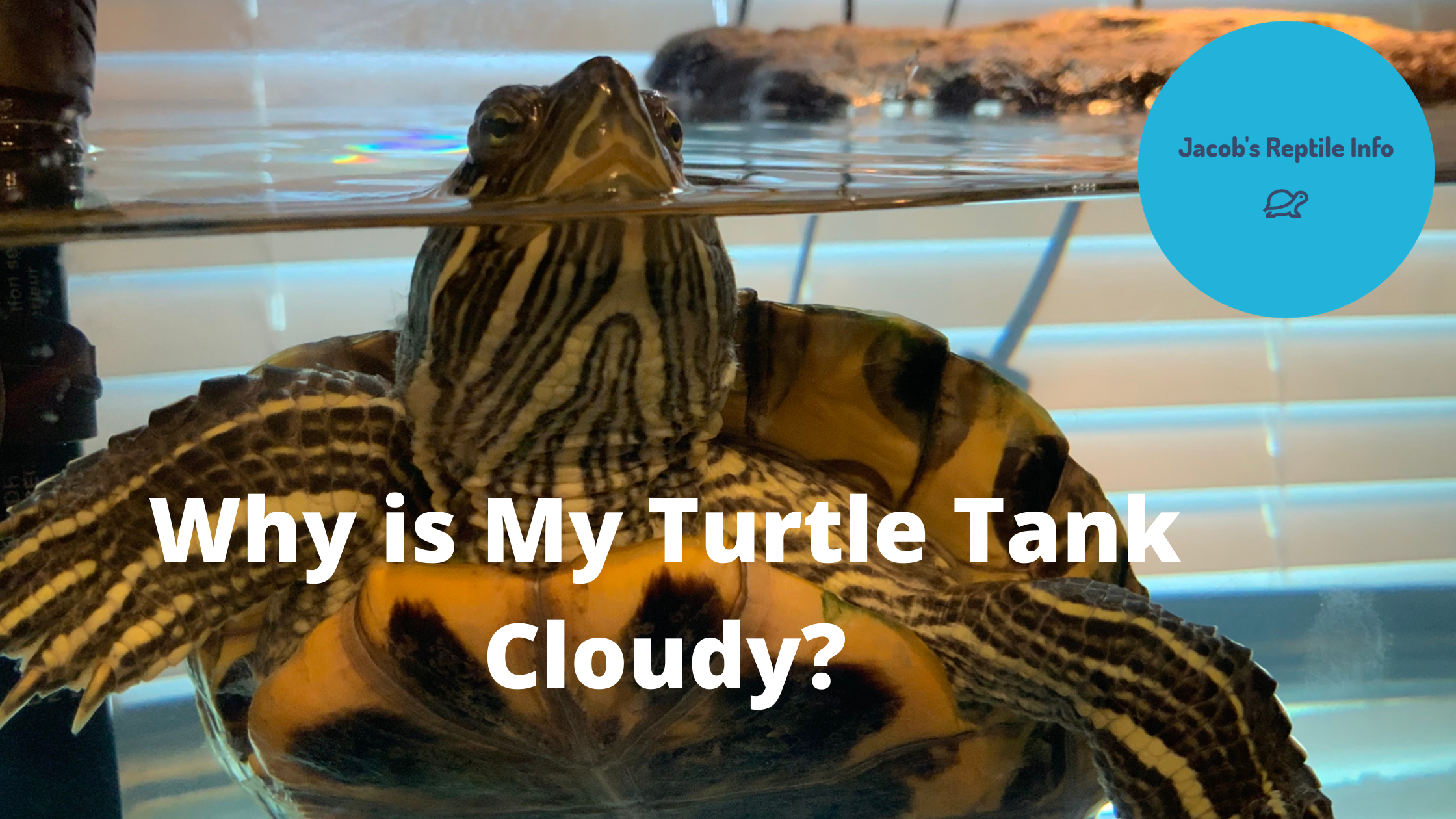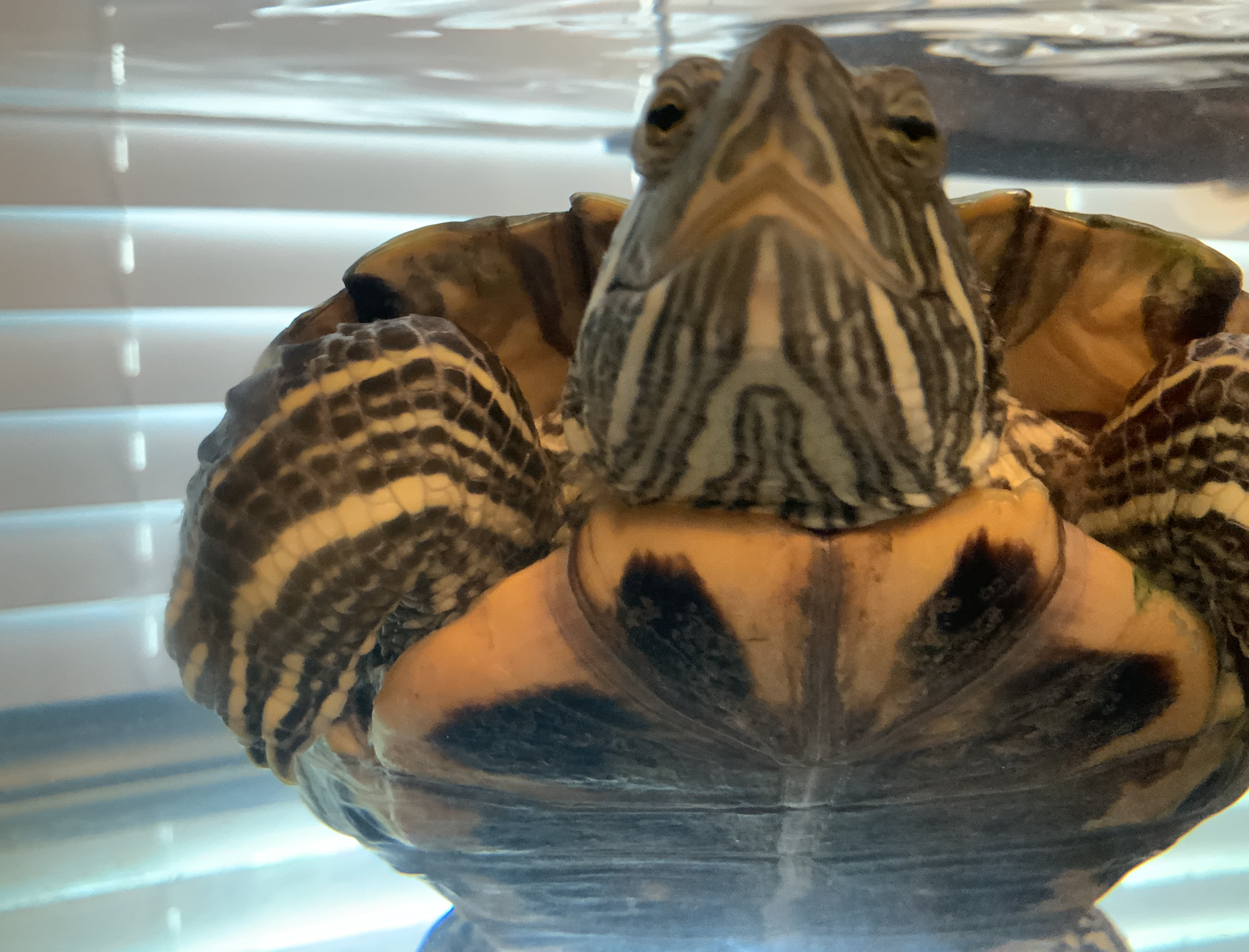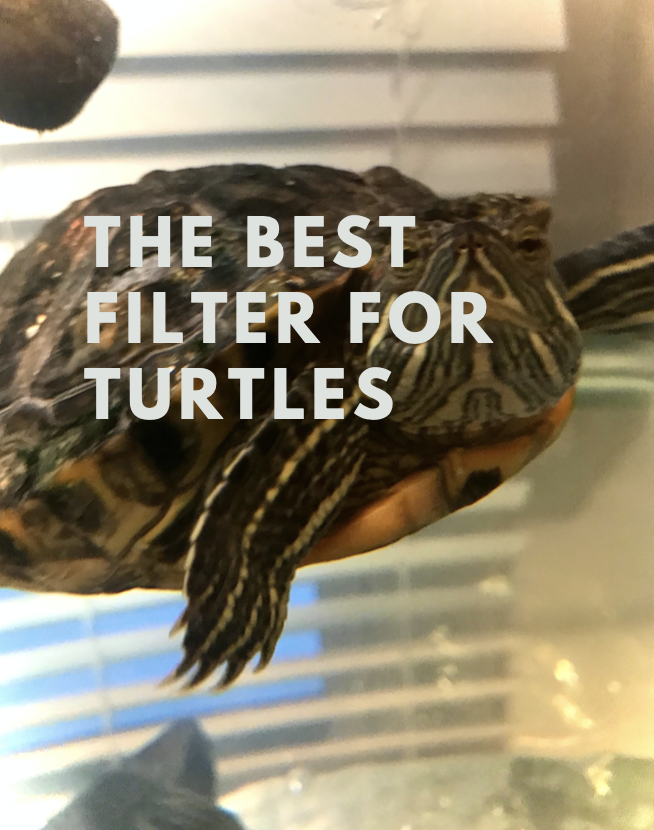How to Care for a Red Eared Slider
2/28/21
As an Amazon Associate I earn from qualifying purchases.
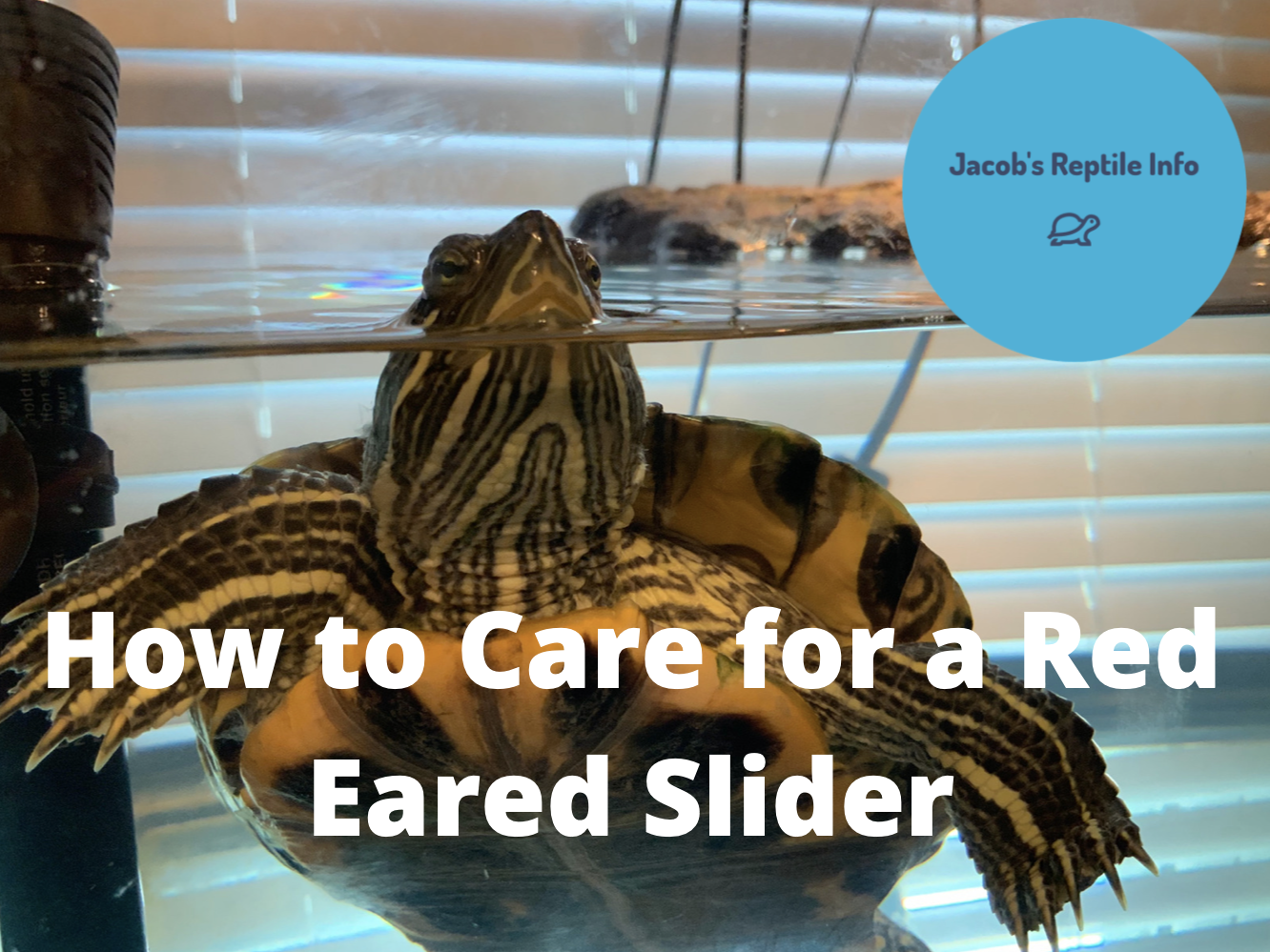
Red-eared sliders (also called the redneck turtle or the red-eared terrapin) are some of the most popular pet turtles. They can live over 20 years in captivity, so they are a big responsibility. They might look easy to take care of, but you will need to get a huge tank, proper lighting, filtration, and more. Red-eared sliders are semi-aquatic, so they need a large swimming area and a place where they can bask. This article explains how to set up a red-eared slider tank, what to feed your turtle, FAQs, and more.
About Red-Eared Sliders
Red-eared sliders are native to the Southern United States and Mexico. Because of pet releases, red-eared sliders are an invasive species and are found in ponds and lakes. Red-eared sliders get their name from the red stripe on the side of their head and the ability to slide off of rocks or other surfaces quickly. Their carapace (upper part of the shell) can grow up to 12 inches long. Males tend to be smaller (5 to 8 inches), while females are bigger (8 to 12 inches). They are the most popular pet turtle in the United States and other countries.
Deciding if a Red-Eared Slider is Right for You
Semi-aquatic turtles, in general, are not easy to care for. Red-eared sliders can end up costing a lot of money. The initial cost can range from 600 to 1,200 dollars. Filter media, food, and other expenses can range from 10 to 30 dollars a month. If you can not afford that, please do not get a red-eared slider. Some people buy a red-eared slider and a cheap tank, and the turtle gets severely sick. You will have to give them water changes every week, which take about 1 to 2 hours. If you can’t do the water changes every week or do not have time to, a red-eared slider is not the right turtle for you. Red-eared sliders are great for people with allergies because you can not be allergic to reptiles. They are very friendly and will get to know you. Red-eared sliders are some of the most active reptiles, and they can be very entertaining. If you have a dog or cat, get a tank with a stand and a secure lid so it can not get to the turtle. Red-eared slider turtles make great pets if you take good care of them.
What Tank Size Do Red Eared Sliders Need?
Red-eared sliders need a large tank. The rule for turtle tank size is 10 gallons per one inch of the carapace (upper part of the shell). You can get a pond or glass aquarium, but glass aquariums are usually better because they take up less room. Baby red-eared sliders can live in 20 to 40 gallon tanks, but adult red eared sliders will need a 65 gallon or more tank. Make sure that the turtle can completely turn around in the tank. Standard 55 and 65 gallon tanks are not wide enough for a turtle. A 75 gallon tank is best for most red-eared sliders. Tanks with stands are great because you can store a ton of supplies and a canister filter in them. Getting the right tank for your turtle is extremely important.
Basking Platform
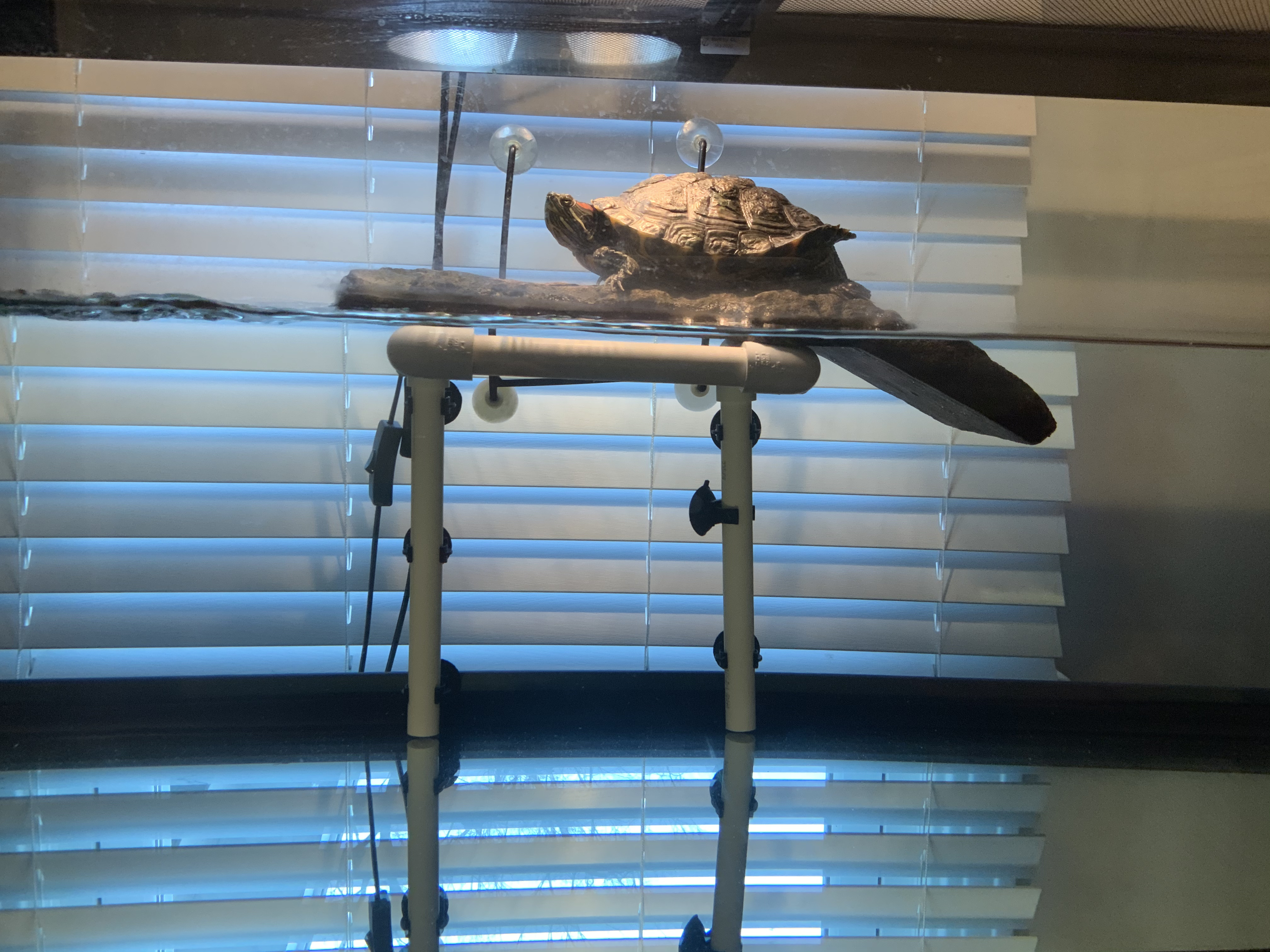
Red-eared sliders need a place where they can get completely dry. A basking platform is a platform that is out of or above the water, usually with a ramp. There are three types of basking platforms; above tank, floating, and rocks/driftwood. Floating basking platforms are great for any turtle. The only downside is that once your turtle gets big, you are going to have to make some adjustments to it. One way to make floating basking platforms stronger is to build a shelf out of PVC pipes. A good floating basking platform is the Zoo Med Turtle Dock. If you want a different basking platform, read the article
Filtration
The right filter for a turtle is important because they are very messy animals. There are nine main types of filters; box filters, canister filters, Diatomic Filters, Fluidized Bed Filters, Power Filters, Sponge Filters, Trickle Filters, HOB filters, and Under Gravel Filter. Not all of these filters are good for turtles. The best type of filter for a red-eared slider is a canister filter. There are many companies that canister filters, but Fluval canister filters are best for turtles because they are strong, powerful, and durable. If you do not want to get a Fluval filter, read the article “The Best Filters For Turtles” for more filter options.
Heater
Red-eared sliders are cold-blooded, so you will need to get a heater to keep them warm. There are two main types of heaters, inline and submersible. Inline heaters attach to the filter. They only work with canister filters and are pricey. Submersible heaters use suction cups to attach to the side of the tank. Submersible heaters are the best heaters for turtles because they are cheaper than inline heaters and they are adjustable. A good submersible heater is the Aqueon Pro Adjustable Heater. It is completely smooth, so red-eared sliders can not bite it and get hurt.
Lighting
Like most reptiles, red-eared sliders need UVB lights. Since red-eared sliders are semi-aquatic, they need waterproof lights. A good waterproof UVB light is the Zoo Med Aquatic Turtle UVB Heat Lighting Kit. Make sure to replace the lights every 10 months. You should set reminders on your phone to change it. Zoo Med has a helpful tool that emails you when you need to change your UVB lights (Here is the link).
Substrate
The best substrate for turtles is questionable. There are three types of substrates for turtles; river rocks, sand, and bare bottom. Other substrates have been used with turtles, but these are the most popular. For beginners, bare bottom tanks are the best because they are the easiest to keep clean.
Turtles and Salmonella
Red-eared sliders carry salmonella in their feces. Since they defecate in the water, the salmonella gets all over them. Because of this, use gloves when you need to handle them and use a disinfectant that kills salmonella on anything the water touches. Never spray chemicals on the turtle. Always be cautious when handling a red-eared slider turtle because they carry salmonella.
Normal Behavior
Red-eared sliders spend most of their time swimming in the water. They will spend 1 to 3 hours a day basking under the UVB light. They might get scared and slide off the basking platform when you enter the room (hence the name red-eared slider). They will sometimes splash water and swim frantically when they get hungry. Red-eared sliders are very friendly and will get to know you. When you first bring your turtle home, they might be lethargic and hide. This is normal and it will stop in a few days.
How to Tell the Gender of a Turtle
It is easy to tell the gender of a turtle. Males have long claws and a thick tail. Females have short claws and a small tail. Females usually grow to be 8 to 12 inches long, while males grow to be 5 to 8 inches long.
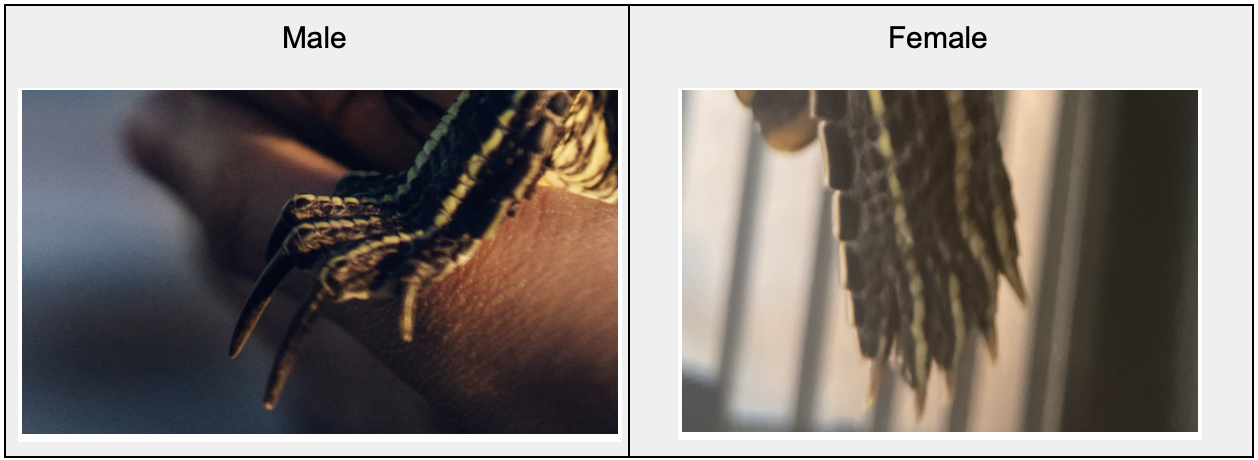
What Do Red Eared Sliders Eat?
Red-eared sliders need a varied diet to thrive. Red-eared sliders need to eat prey food, pellet food, leafy greens, and some other vegetables. Here are some foods that they can have:
Leafy greens: collard greens, kale, dandelion greens, mustard greens, and bok choy. You should never feed your red-eared slider iceberg lettuce because it does not contain enough nutrients.
Prey items: crickets, shrimp, feeder minnows, mealworms, wax worms, and aquatic snails. Goldfish should not be fed to turtles because they contain too much fat.
Other vegetables and fruits red eared sliders can eat: Squash, carrots, apples, and green beans. If you have a smaller turtle, you can shred the vegetables to make them easier to eat.
Commercial turtle food: Zoo Med Natural Aquatic Turtle Food, Fluker's Freeze-Dried River Shrimp, and Hikari Wheat Germ Pellets (for when your turtle is shedding).
Younger turtles should be fed more commercial turtle food than vegetables and leafy greens. Commercial turtle food should make up 25 percent of older turtles’ diets and 75 percent should be vegetables, fruit, prey items, and leafy greens. It is important to keep your red-eared slider healthy by feeding it the right foods.
The Supplies You Will Need
Before getting any pet, it is a good idea to get the supplies first. Here is a list of the supplies you will need. These are all of the suggested products mentioned in this article. Please note that these are the prices as of 2/28/21.
Tank - Marineland Majesty 75 gallon tank $499.99 (Petsmart)
Filter - Fluval 307 Performance Canister Filter $179.99 (Petsmart)
Lighting - Zoo Med Aquatic Turtle UVB Heat Lighting Kit $36.59 (Amazon)
Heater - Aqueon Pro Adjustable Heater 100w $39.99 (Amazon)
Screen lid - Fluker Labs Metal Screen Cover, 18 by 48-Inch $49.96 (Amazon)
Thermometer - Top Fin Digital Aquarium Thermometer $14.99 (Petsmart)
Suction cups - Pawfly 12 Pcs Aquarium Heater Suction Cups $6.99 (Amazon)
Bucket - 5 Gal. Homer Bucket $3.78 (The Home Depot)
Siphon - Laifoo Aquarium Vacuum Gravel Cleaner $29.99 (Amazon)
Water conditioner - API TAP Water Conditioner $19.99 (Amazon)
Waste remover - Fluker’s Eco Clean $14.99 (Amazon)
Water clearer - API ACCU-CLEAR $4.39 (Amazon)
Glass scrubber - API Algae SCRAPERS $7.79 (Amazon)
Disposable gloves - Medpride Vinyl Gloves $15.99 (Amazon)
Freeze-dried shrimp - Fluker's Freeze-Dried River Shrimp $5.99 (Amazon)
Turtle pellets - Zoo Med Natural Aquatic Turtle Food $15.44 (Amazon)
Net - FISH PROS Fine Mesh Fish Tank Net $10.97 (Amazon)
Basking platform - Zoo Med Turtle Dock $39.99 (Petco)
Toothbrush - about $3 (any toothbrush will work, just make sure it is brand new.)
Temporary holding box - Imagitarium Pet Keeper for Aquarium Fish, Large $13.99 (Petco)
Turtle - $5 to $30
Total: $1044.80 (not including tax)
How to Setup a Red-Eared Slider Tank
Once you have gotten all the supplies, you need to set up the tank. Place the tank in an area that you are frequently in, so the turtle can get lots of attention. You should fill the tank up with water, and the water level should be as tall as your turtle’s carapace. Place the basking platform in the right position (towards the back of the tank if it is a turtle dock, on top of the tank if it is an above-tank basking platform, or place it anywhere you want if it is rocks/driftwood). Follow the directions on your filter and install it properly. Canister filters work best when they are below the water level. If you have a canister filter, you can put it under the stand to make it look nicer. Put the heater in the tank and let it sit for twenty minutes before plugging it in. Once you plug it in, turn the knob to 77 degrees Fahrenheit (25 degrees Celsius). Place the thermometer in the tank (you can use electrical tape to secure it if the suction cup is not working). Put the screen lid on top of the tank (you can use screen clips to hold it in place if it keeps coming off). Screw-in the UVB bulbs into the fixture and put it on the lid, (or above-tank basking platform) above the basking platform. Add the right amount of water conditioner to the tank. Let the tank cycle for two days before getting the turtle.
Where to Get a Red-Eared Slider
You can find Red-eared sliders at almost any pet store, but not all places have healthy turtles. Do not get a red-eared slider from a big-box pet store because they often put too many turtles in one tank. This can lead to turtles getting hurt and aggressive. Get your turtle from a reptile store, a reptile show, or a pet store that gets their turtles from a breeder. Call a place that you find and ask them how old the turtles are and how many they have before getting one. It is best to get a younger turtle so you can watch them grow up and so you can have them for a long time.
Picking out a Healthy Turtle
It is important that you get a healthy red-eared slider. Look for bad signs like gasping for air, white spots on the shell, scar tissue, and cuts. Make sure the turtle is swimming around the tank and not hiding. If you have a chance, pull on the turtle’s legs to see if it has good reflexes.
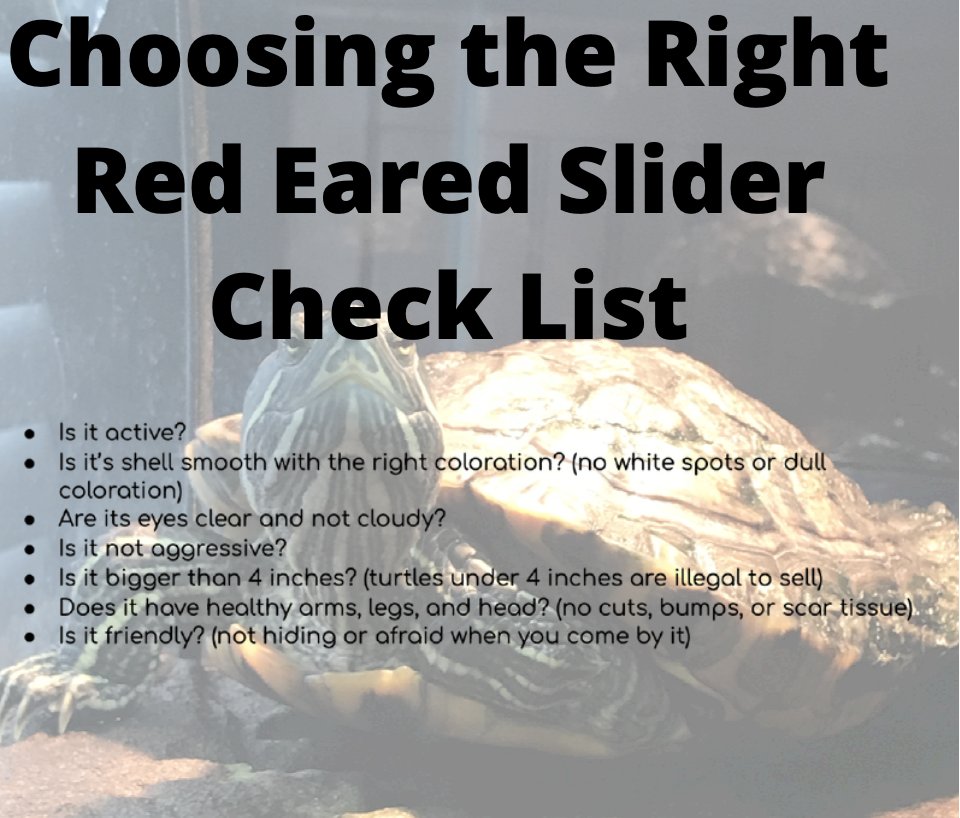
Bringing Your Red-Eared Slider Home
Once you pick out your turtle, you will need to bring it to your house. There are a few ways to get your turtle home. The best way is to get a large temporary fish holding tank. They have lids, so your turtle can not get out in the car and make a mess. The place that you get the turtle at might have them, but you should buy one before in case they do not have them. Buy the biggest one you can find so your turtle has enough room. You should save the container because you will need it for taking the turtle to the vet. If it is cold out when you get the turtle, place the turtle in the passenger seat with the heat on so the turtle won’t get cold. Hold the turtle still so it does not get scared. You can even put a blanket or towel over the container if the turtle is getting scared.
FAQs
Here are some frequently asked questions about red-eared sliders.
Question: Why is my turtle shedding its shell?
Answer:
Turtles will shed their shell and skin as they grow. It usually happens once or twice a year. Your turtle might try to eat the pieces that came off, but this is normal and won’t hurt them. If you think your turtle is having trouble shedding its shell, you can scrub its shell with a soft bristle toothbrush. Do not pull the pieces off, as it can hurt the turtle and damage its shell. To aid shedding shells, you can feed your turtle Hikari Wheat Germ Pellets. The pieces will usually fall off within 1 to 2 weeks. The shedding skin will stop in a few days.
Question: Why is the water in my turtle tank cloudy?
Answer:
This can happen for multiple reasons. For more information on this topic, read the article “How to Get Your Turtle’s Water Crystal Clear”.
Question: Do I need to take my turtle to a vet?
Answer:
You should take your turtle to an exotic pet vet or a reptile vet once a year for a checkup. Bring pictures of your tank setup when you go so your vet can give you suggestions on how to improve it.
Question: Do I need to dechlorinate the water after every tank clean?
Answer:
Yes, the water needs to be dechlorinated whenever you add new water. You should also add waste remover and or Accu Clear when you add new water.
Question: How often should I change the filter media?
Answer:
You should rinse out the filter media once a month. The filter media should be replaced every two months. The inside of the filter should be wiped down once a month.
Question: Can red-eared sliders eat outside of the water?
Answer:
No, semi-aquatic turtles can only digest food in water. If you want to feed your turtle outside of the tank, use a container full of water to feed your turtle in.
Red-eared sliders make great pets. They can live over 20 years and get to be 12 inches long. They are the most popular pet turtles in the United States and other counties. Red-eared sliders require a lot of work, but they are friendly and very active pets.
